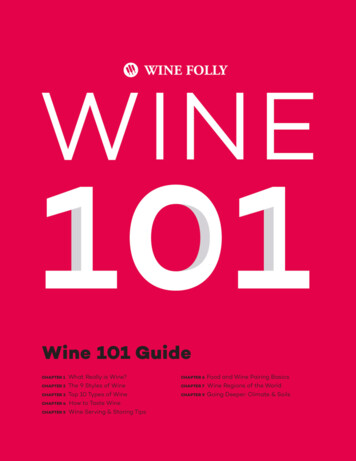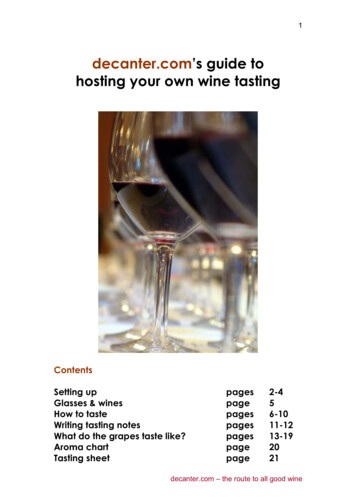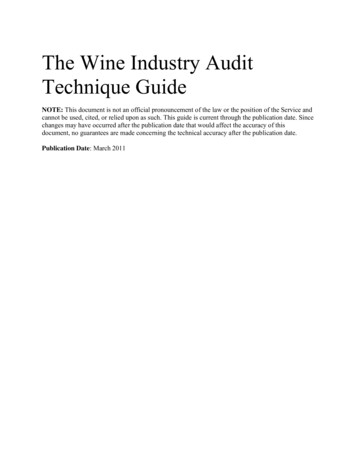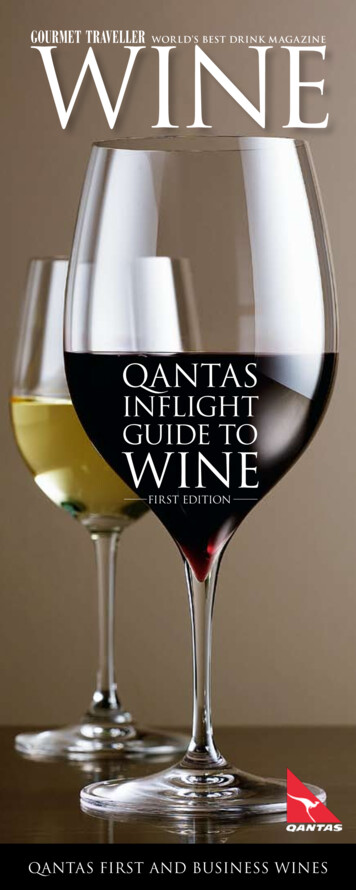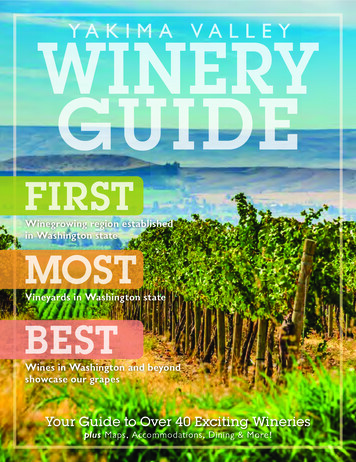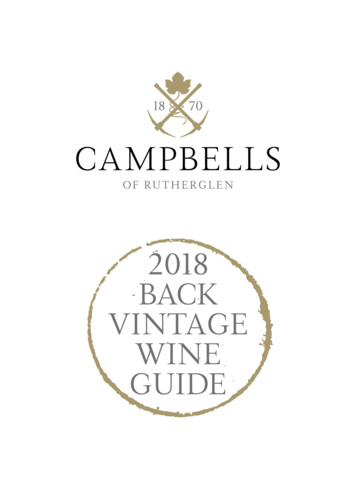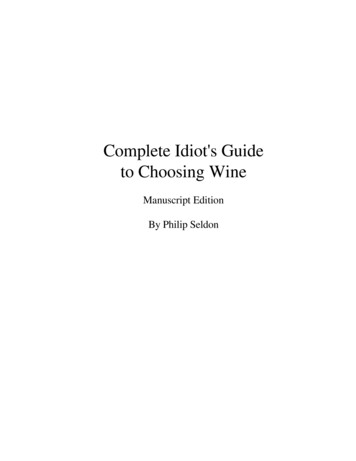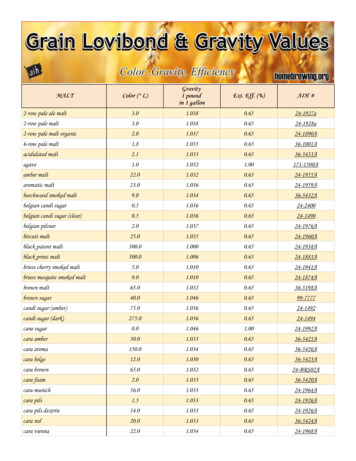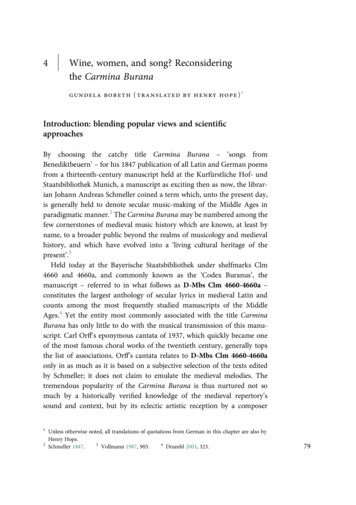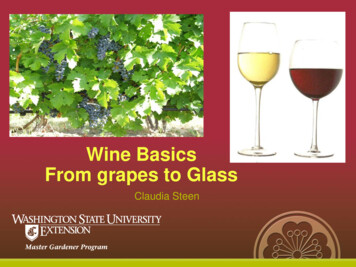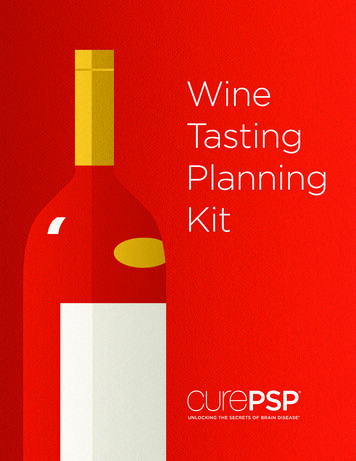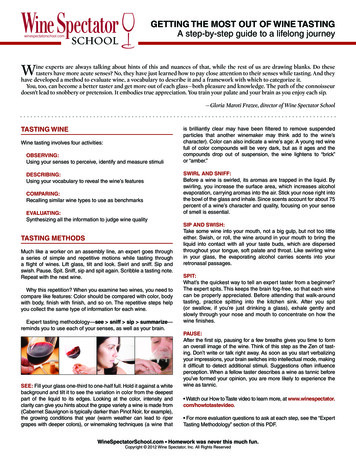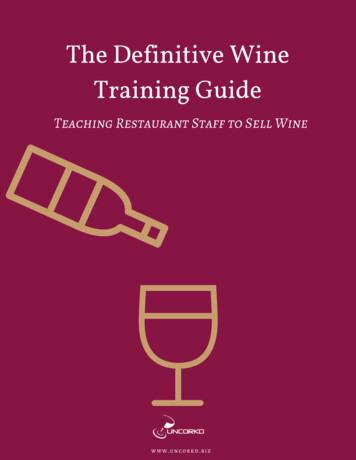
Transcription
The Definitive WineTraining GuideTeaching Restaurant Staff to Sell Winewww.uncorkd.biz
Why Use This Guide?The world of wine can be intimidating. Wine culture has a deep history and anever-changing present. That history – full of unfamiliar château names,extensive varietals, and misunderstood terms – can make becomingknowledgeable about wine seem like a lifelong process.But learning about wine doesn’t have to be scary for new servers. With the rightfocus and a blend of education and fun, you can train your staff to becomeexperts at selling wine. This is different than becoming a wine expert.Your chief concern is thatyour staff is able to sell the wine on your menu.This guide will help you build astrategy to train staff on how to sellwine.www.uncorkd.biz
Table of ncorkd.bizSells
1. New Employee TrainingThe restaurant industry has a 72%turnover rate for staff.*Managers are constantly hiring andtraining new employees while watchingveteran staff leave.By creating a standard training program,you can create consistency in yourrestaurant.It’s important to recognize that trainingcan have a strong impact on employeeturnover rate. The right training andcoaching of staff can keep employeesengaged and happily employed.A study on employee commitment,Public Personnel Management, detailedthat proper training decreases anemployees likelihood to leave a job by9%.New employee training should focus onthe experience of tasting wine andclearly communicating to guests what toexpect from a wine. Communication iskey in sales, and selling wine is nodifferent.It’s important to remember that just asnew hires may be intimidated by wineservice, your guests can be just asuncertain.The most important aspect of beginnerwine training is giving novices theconfidence to speak intelligently aboutwine to their guests.It's crucial to practice a consistent winetraining program to ensure consistencyin your restaurant and retain staff.Proper trainingdecreases anemployeeslikelihood to leave ajob by 9%The restaurantindustry has 72%turnover rate forstaff*Per 2015 Bureau of Labor Statistics reportwww.uncorkd.biz
Let's Talk Over WineThe best place to begin training is with asimple and honest conversation aboutwine. Talk about your own personalwine preferences, and ask them abouttheirs.Hearing your new staff talking aboutwine in a casual setting will give you abetter understanding of their baselineknowledge.Drinking wine is the best way tounderstand how to talk about wine. Butbefore you begin tasting with trainees,it’s best practice to compile notes anddocuments to use during and aftertastingProviding new hires with wine notes isimportant. Compile a binder that hastasting notes and information on all yourwines. If it’s too difficult to cover allwines, then start with your by-the-glasspours.25% ofwine drinkers areintimidated buyingnew wine *Tech SheetsThese are easy to get from yourwine distributors. Just ask forthem in email, or bring printedcopies to your restaurant.Personal TastingThese notes are more timeconsuming to create, butwhoever is in charge of your wineprogram can put these togetherand add relevant selling points,and instruct on preferredlanguage and style of selling foryour restaurant.Grape InformationGiving background informationon grape varietals can be veryhelpful for wine novices. It givesthem familiarity whenapproaching your wines, and willhelp them in speaking about thedifferences between wine stylesto guests.Communication between server and guest iscrucial for making guests feel the confidence totry a new wine. This “discovery” experience willturn a good experience into a great one.*Per 2015 Wine Consumer Survey from Taste4 Wine Servicewww.uncorkd.biz45% ofwine drinkers areloyal to theirfavorite grape*
Learning How to TasteIt's important for new hires to learn howto taste.Reserve some privacy for your tasting sotrainees will feel comfortable.Not everyone has been to a wine tasting,but there are certain practices that willyield a more educational training.After tasting a wine, have your new hirefill out a tasting sheet and write downpersonal notes on their tastingexperience. This can be used inconjunction with the notes you’veprovided.A wine tasting should be done after atraining shift, not before. Or done at adedicated time when a trainee won’t beresponsible for anything besidestasting.It’s best to taste white wines on aseparate occasion from reds. Yourpalate can be overworked.Having staff write personal tastingnotes is important because it will makethem more comfortable using their ownlanguage to describe wines.Great, free resources to take advantage ofJust click the text below and be whisked away to wine resourceheaven.Wine Basics: A Beginners Guide to WineHow to Write Excellent Wine Tasting NotesCertified Exam Tasting Grid - WhiteCertified Exam Tasting Grid - Redwww.uncorkd.biz
The Elements of TastingWine tasting makes use of our animalistic hunting senses: Sight, Smell, Taste.Appearance: Wine tasting begins withanother sense: Sight. Familiarize yourstaff with how a wine looks before youtaste.Color – general wine colorOpacity – how transparent ortranslucent a wine isViscosity – the weight of a wine asdetermined by alcohol volume.2. Smell: What aromas do you get fromthe wine? It’s important to teach staff tosmell, because the sense of smell isintegral to taste.3. Taste: The big 4 flavors: Salty, Sweet,Sour or Bitter will all be at play here.Also look for flavors that arereminiscent of more familiar foods orelements. These relatable terms helpsell.Look for Fruit, Floral, Earth, and Mineralwww.uncorkd.bizTo heightenflavors, openmouth slightly andbreath throughyour mouth andnose at the sametime.
Sell Me On ItWhen selling wine, it's important to ignore using wine jargon and instead use terms thatact as selling points. The following are common wine phrases that customers look for inwine descriptions.DRYIt's Important that servers know whereyour wines fall on the dry/sweet spectrumFRUITYA better word than sweet. Often used todescribe Pinot Noir.CRISPUsed for lively whites like Sauvignon Blanc.Connotes acidity and bright citrusSOFTFor easy drinking wines. Used with reds likeGamay or Grenache, and whites like CheninBlanc or Riesling.RICH/BIGCan be used for both reds and whites. Oftenused for hearty reds like BordeauxOAKY/UNOAKEDCommon Chardonnay descriptor referringto barrel influence.SPICY/PEPPERRed wines like Malbec can often bedescribed as peppery.TANNICFor wines with a dry & puckery finish.Tannsin are bitter compounds from wood.www.uncorkd.biz
Taste TestIt’s important to have a written testafter your tastings. The idea of alooming test inspires accountability inyour trainees.Give staff 2-3 days to study afterfinishing wine tasting before giving themtheir test. Remember, a test is there toencourage accountability, and to makesure staff knows information about yourwines, and how to sell them.A wine test should show what traineesknow and if they can communicateabout wine. A test shouldn’t be used to“catch” staff’s shortcomings. Somebeverage directors choose to allowthese tests to be open-book.This is one approach, but memorizationand calling information to mind withoutaid will be helpful during service whenstaff is serving a table.Tech tips for study sessionsTo help staff study for their wine tests,have them set up an account withQuizlet. It's a free and simple tool tobuild flashcards, study guides, andquizzes. The nice part is that the websiteis mobile friendly, so staff can study offof their phone without the need ofdownloading an app.Taking advantage of technology tocommunicate with younger staff isimportant. Sending quizzes, tastingnotes, and reminders via email, orthrough messaging features onscheduling apps like Hot Schedules willmake improve your communication withnew employees.www.uncorkd.biz
2. On-going Coaching for StaffIt’s important to continue training andcoaching your employees after the newhire training period is over. Coaching isan important aspect of managingemployees. It’s also one of the mostunderrated and underperformed rolesof management.Coaching keeps employees engaged,and helps to build better relationshipsbetween management and staff. Thisisn’t about lecturing or scolding staff ifthey make a mistake, it’s aboutcontinually relaying useful knowledgeand skills that will help them grow intheir position.Continued wine education shouldexpand on your new staff training. Whentraining new staff, the focus should betraining staff to feel comfortable sellingthe wines on your menu. But continuededucation should have a broad focus,and give staff deeper knowledge on thewine.There are many great resources to helpyou build your on going trainingprogram. It's important that yourrestaurant becomes a resource ofinformation for staff.That sounds like a lot of responsibility.But don't worry! You're in luck! There isplenty of great wine informationavailable to you that is already compiledin neat packages like books and youtubevideo series.Intoxicating resources to start withWindows on the WorldThe Wine Bible by Karen MacNeilComplete Wine Course by KevinZralyA top selling wine book with anupdated edition that is "A guideThe top selling wine book in thethat has all the answers." A veryworld that comes with quizzes toapproachable book that lends atest yourself on the material.global view on wine.WSET 3 Minute Wine SchoolA video training series onYouTube that features the mostknowledgable industry prosbreaking down wine regions andgrapes in 3-minute videos.www.uncorkd.biz
Areas To Focus Training OnOnce your staff has a foundationalunderstanding of different varietals andthe common characteristics of populargrapes, then you can begin buildingknowledge on where grapes are grownthrough out the world. It’s important tounderstand that wine is a globalproduct, and just where exactly a wine isproduced can have a significant effecton a wine’s qualities.Wine RegionsIt's important that your starservers know their wine regionswell. Wine regions impart certaincharacteristics on wines, so beingable to understand and referenceregions will help sell to customers.Grape VarietalsUnderstanding the global connectionbetween grapes is important for serversbecause it gives them the knowledge tomake wine suggestions and encourageguests to travel through the world ofwineUnderstanding grape varietalsand their qualities is key foradvanced wine selling. Winedrinkers are often loyal to certaingrapes, and being able to up sellbased on varietal preference willincrease sales.Old World vs New World WinesCoaching helpsstaff grow theirskills. They willreciprocate thiscoaching withloyalty to their job,Staff should be familiar with thedifferences between Old and NewWorld wines. If a guest asks aboutBurgundy Reds, your staff shouldbe able to sell them an OregonPinot Noir. Understanding OldWorld regions and their relevantgrapes is important.Food Wine PairingPairing a wine with food elevatesa meal into an amazingexperience. Train your staff topair your stellar dishes withstellar wines.www.uncorkd.biz
Wine Pairing ChartClick on the image for version to print, or use the image link to share it with a friend.www.uncorkd.biz
3. Sticking to the ProcessAfter building out your training processand finding the best course to train stafffor your restaurant, it's important tostick to the process.Why waste all that hard work ofdeveloping a program to train staff andnot utilize it for every new hire andveteran staffer you have on the floor.Consistency is key when it comes totraining. Your program may seem like alot of work at first, and it may even scaresome staff away, but that's okay. Whenyou look onto the floor during service ona busy Saturday night, you'll beconfident knowing you have a team ofall-stars selling wine.Wine is the cornerstone of the beverageindustry. Despite the growth of the craftbeer industry and the revival of cocktailsand brown spirits, wine is still theleading revenue generator for manyrestaurants.But realize that consumer preferencesare shifting, and new wineries andimports are changing the look of manywine menus. It's important that youtweak and update your wine training toinclude modern trends.Wine doesn't have to be intimidating.Remember, you don't need a staff ofsommeliers. You just need staff whocan sell your wine.Bonus resources to keep staff freshUncorkd Digital Menus are agreat, modern way to help trainyour staff and keep theirknowledge vibrant.Restaurants that use Uncorkddigital menus utilize our experttasting notes to train staff duringpre-shift and through out service.Wine Reps are top notchresources to use for winetraining. Your reps will come inand train your staff on theirwines.Since they're in the business ofwine sales, their training willfocus on teaching your staff tosell.www.uncorkd.bizWine Tastings and Events arefun ways for staff to taste wineout in the wild.It keeps them up-to-date withnew releases and makes for agreat team bonding experience.
Thank you for reading the Definitive Guide to Wine Training by Uncorkd!Uncorkd is a digital menu solution that gives restaurants more control overtheir beverage program. With Uncorkd, you can update selections instantlywith no need to reprint menus. And our menu analytics help you makebetter decisions for your business.We found that the key to increasing sales is simple: educate guests. Ourextensive beverage database provides expert tasting notes to use on yourmenus and give guests the informed confidence to spend more on theirbeverage choice.To learn more about how Uncorkd digital menus work to grow beverageprograms and increase beverage sales, click the link below to visit ourwebsite or call us:www.uncorkd.biz773.683.1492
A wine tasting should be done after a training shift, not before. Or done at a dedicated time when a trainee won’t be responsible for anything besides tasting. It’s best to taste white wines on a separate occasion from reds. Your palate can be overworked. Great, free resources to take ad
